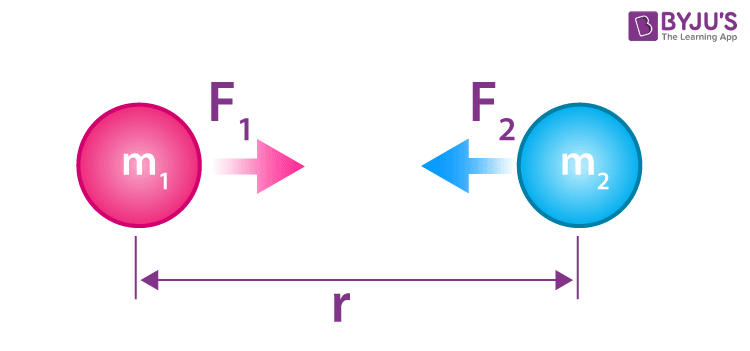Gravitation or gravity is the force of attraction between any two bodies. All the objects in the universe attract each other with a certain amount of force, but in most cases, the force is too weak to be observed due to the very large distance of separation. Besides, gravity’s range is infinite, but the effect becomes weaker as objects move away.
Download Complete Chapter Notes of Gravitation
Download Now
This force of attraction was first observed by Sir Isaac Newton and was presented as Newton’s law of gravitation in the year 1680. However, gravitation can generally exist in two main instances.
1. Gravitation may be the attraction of objects by the earth
For example,
If a body (ball) is thrown upwards, it reaches a certain height and falls downwards because of the gravity of the earth.
2. Gravitation may be the attraction of objects in outer space.
For example,
The force of attraction between the other planets and the sun.
Table of Contents
- Gravitational Force
- History
- Newton’s Law of Gravitation
- Vector Form
- Formula
- Derivation from Kepler’s Law
- FAQs
What Is Gravitational Force?
Each body in this universe attracts other bodies towards itself with a force known as Gravitational Force. Thus, gravitation is a study of the interaction between two masses. Out of the two masses, the heavier one is called source mass, and the lighter one is called test mass.
Gravitational force is a central force which depends only on the position of the test mass from the source mass and always acts along the line joining the centres of the two masses.
The core problem of gravitation has always been in understanding the interaction between the two masses and their relativistic effects.
⇒ Also, Check: Gravitational field intensity
History of Gravitational Theory
Ptolemy proposed the geocentric model, which failed to understand planetary motions, and led to the development of the heliocentric model by Nicholas Copernicus. His idea is based on the rotation of a test mass around the source mass in circular orbits; although the model correctly predicts the position of planets and their motions but has failed to explain many aspects, like the occurrence of seasons, which led to the construction of a model based on Kepler’s laws of planetary motion.
Newton’s Law of Gravitation
According to Newton’s law of gravitation, every particle in the universe attracts every other particle with a force whose magnitude is,
- Directly proportional to the product of their masses, i.e., F ∝ (M1M2) . . . . (1)
- Inversely proportional to the square of the distance between their centre, i.e., (F ∝ 1/r2) . . . . (2)
On combining equations (1) and (2), we get,
F ∝ M1M2/r2
F = G × [M1M2]/r2 . . . . (7)
Or, f(r) = GM1M2/r2 [f(r) is a variable, non-contact, and conservative force]
As f(r) varies inversely as a square of ‘r,’ it is also known as the inverse square law force. The proportionality constant (G) in the above equation is known as the gravitational constant.
The dimension formula of G is [M-1L3T-2]. Also, the value of the gravitational constant,
- In SI units: 6.67 × 10-11 Nm2 kg-2,
- In CGS units: 6.67×10-8 dyne cm2 g-2
Vector Form of Newton’s Law of Gravitation
The vector form of Newton’s law of gravitation signifies that the gravitational forces acting between the two particles form action-reaction pair.

From the above figure, it can be seen that the two particles of masses are placed at a distance.
The direction of the vector is from M1 to M2
Therefore, the force applied on M2 by M1 is
The negative sign indicates the attractive nature of the force.
Similarly, force on M1 and M2
Since,
Hence, the applied forces are equal and opposite. Also, the gravitational force follows Newton’s third law.
Gravitational Force Formula

Gravitational force is explained using Newton’s law of gravitation. Gravitational force decides how much we weigh and how far a ball travels when thrown before it lands on the ground.
Also Read: Important Gravitation Formulas for JEE
According to Newton’s law of gravitation, every particle in the universe attracts every other particle with a force that is directly proportional to the product of their masses and inversely proportional to the square of the distance between them.
Mathematically, it can be represented as,
- F is the gravitational force between two objects measured in Newton (N).
- G is the universal gravitational constant with a value of 6.674 × 10-11 Nm2kg-2.
- m1 is the mass of one massive body measured in kg.
- m2 is the mass of another massive body measured in kg.
- r is the separation between them measured in kilometre (Km).
Principle of Superposition of Gravitational Forces
Newton’s law of gravitation answers only the interaction between two particles; if the system contains ‘n’ particles, there are n(n – 1)/2 such interactions.
According to the principle of superposition, if each of these interactions acts independently and uninfluenced by the other bodies, the results can be expressed as the vector summation of these interactions:
F = F12 + F13 + F14 . . . . . . + F1n.
It states that:
“The resultant gravitational force F acting on a particle due to the number of point masses is equal to the vector sum of forces exerted by the individual masses on the given particle”.
Derivation of Newton’s law of Gravitation from Kepler’s Law
Suppose a test mass is revolving around a source mass in a nearly circular orbit of radius ‘r’ with a constant angular speed (ω). Then, the centripetal force acting on the test mass for its circular motion is,
F = mrω2 = mr × (2π/T)2
According to Kepler’s 3rd law, T2 ∝ r3
Using this in force equation, we get,
F = 4π2mr/Kr3 [Where, K = 4π2/GM]
⇒ F = GMm/r2, which is the equation of Newton’s law of gravitation.
Solved Examples
1. What is the force of gravity acting on an object of mass 2000 kg at the Earth’s surface?
Given:
Mass of Earth (m1) = 5.98 × 1024kg
Mass of object (m2) = 2000kg
The radius of the Earth (r)= 6.38 × 106m
Acceleration due to gravity (g) = 9.8 m/s2
Universal constant (G) = 6.67 x 10-11 N m2 / kg2
Solution:
F = Gm1m2/r2
F = ( 6.67 x 10-11) (5.98 × 1024)(2 x 103)/(6.38 × 106)2
F = (7.978 x 1017)/ (4.07044 × 1013)
F = 1.959 x 104 or F = 19.59 N
2. What is the force of gravity acting on an object of mass 1000 kg at 20,000 meters above the Earth’s surface?
Given:
Mass of Earth (m1) = 5.98 × 1024kg
Mass of object (m2) = 1000kg
The radius of the Earth (r)= 6.38 × 106m
Acceleration due to gravity (g) = 9.8 m/s2
Universal constant (G) = 6.67 x 10-11 N m2 / kg2
h = 2 x 104 m
Solution:
F = Gm1m2/(r +h)2
F = ( 6.67 x 10-11) (5.98 × 1024)(1 x 103)/(6.38 × 106 + 2 x 104 )2
F = (3.988 x 1017)/(4.058 x 1013)
F = 9,827.50
F = 0.9827 x 104
Related Links
Gravitational potential energy
Read More:
Gravitation Rapid Revision for JEE

What Is Gravitation? – Video Lesson

Gravitation – Top 10 Most Important and Expected JEE Questions

Frequently Asked Questions on Gravitation
Will your weight be constant when you are travelling to Greenland from Brazil?
Can you screen the effect of gravitation by any material medium?
Why are space rockets launched eastward?
Why does a bouncing ball bounce higher on hills than on planes?
The gravitational potential energy is negative. Why?
Why is Newton’s law of gravitation called universal law?
Newton’s law of gravitation holds good irrespective of the nature of the interacting bodies at all places and at all times.
What is the weight of the body at the centre of the Earth?
The weight of the body at the centre of the earth is zero.
W = mg = 0
(g at the centre of the earth is zero).
Does friction arise due to gravitation?
Friction does not arise due to gravitation. Its origin is electrical in nature.

Comments